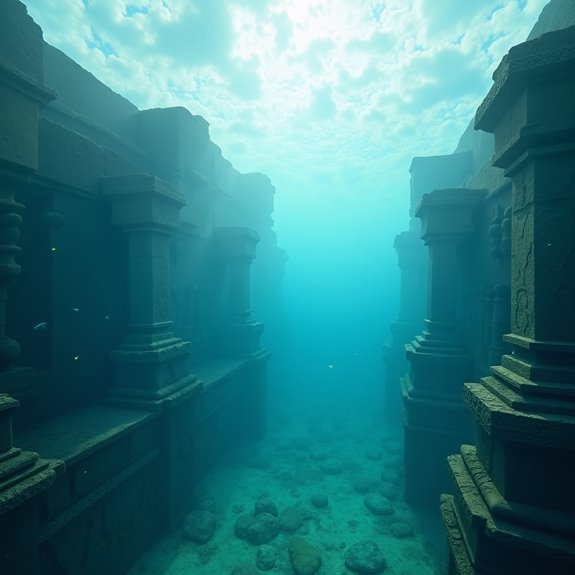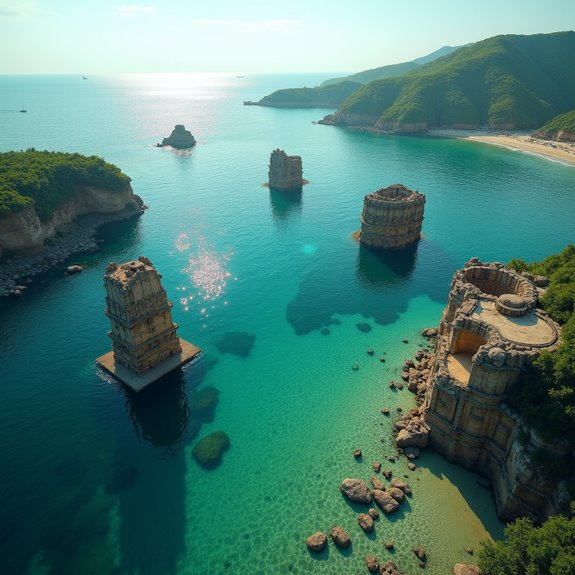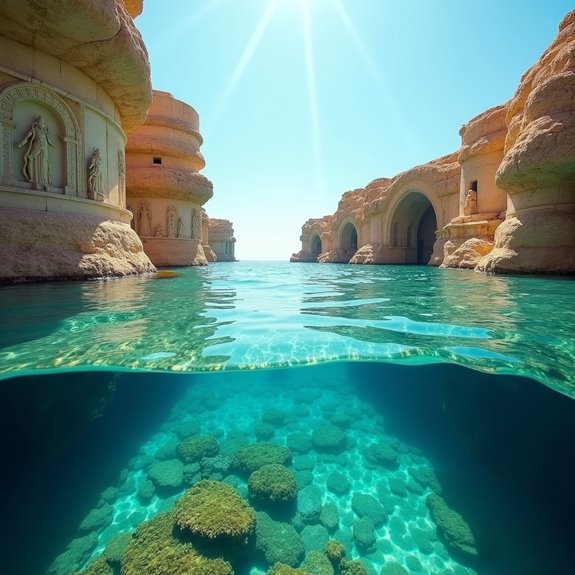The Lost City of Dwarka in India
The Lost City of Dwarka remains an enigma that captivates scholars and enthusiasts alike. Submerged beneath the waters off Gujarat, its ruins hint at a once-thriving civilization linked to the legendary Lord Krishna. This ancient city’s strategic position likely fostered significant maritime trade with distant lands. Yet, the truth behind its existence and the cultural exchanges it facilitated continues to spark curiosity and debate in historical circles. What awaits discovery beneath the waves?
Introduction

The Lost City of Dwarka, often shrouded in mystery, has captivated historians and archaeologists alike for centuries. This ancient city, located off the coast of Gujarat, India, is said to be the legendary home of Lord Krishna, a central figure in Hindu mythology. Its underwater ruins are a demonstration to a civilization that thrived thousands of years ago, sparking debates about its historical existence. Many believe Dwarka was once a bustling metropolis and a vital cultural hub. Its discovery has generated intense interest, leading researchers to explore its geological and archaeological aspects. Today, the story of Dwarka continues to intrigue scholars, igniting curiosity about whether truth and myth intertwine in this submerged domain, waiting for further exploration and understanding.
Ancient Maritime Trade Routes

Although much of Dwarka lies submerged, its strategic location suggests it played a crucial role in ancient maritime trade routes. Positioned along the western coast of India, Dwarka served as an essential hub connecting the Indian subcontinent with regions like Mesopotamia and East Africa. Traders navigated the Arabian Sea, exchanging goods such as spices, textiles, and precious stones. The city likely facilitated cultural exchanges and spread technologies between diverse civilizations. Archaeological findings, including ancient docks and artifacts, support the notion that Dwarka was a bustling trade center. Its robust maritime infrastructure would have guaranteed safe transit for merchants. This thriving commerce contributed substantially to the economy and influence of the region, underscoring Dwarka’s importance in ancient maritime history.
Notable Cases or Sightings

Numerous accounts and sightings have fueled intrigue surrounding the lost city of Dwarka. In 1963, marine archaeologist S.R. Rao discovered submerged structures off the Gujarat coast, suggesting the existence of an ancient city beneath the waves. Explorers reported seeing large stone blocks, foundations, and remnants of walls, sparking theories about Dwarka’s grandeur. Local fishermen occasionally claim to have spotted artifacts while fishing in the region, adding to the city’s allure. Additionally, in 2001, sonar mapping identified patterns resembling streets and buildings lying under the sea, igniting further interest among researchers. These notable cases highlight ongoing curiosity about Dwarka, leaving many to wonder whether the legendary city truly exists just beneath the ocean’s surface, waiting to be fully uncovered.
Common Theories or Explanations
While various theories attempt to explain the lost city of Dwarka, many scholars agree on a few key ideas that shed light on its fascinating history. One prevalent theory suggests that Dwarka was submerged due to rising sea levels, possibly during a massive earthquake. Archaeological findings in the Gulf of Khambhat support this idea, revealing remnants of ancient structures beneath the water. Another theory posits that Dwarka was built in a strategic location to control trade routes, making it a flourishing port city. Some researchers view the city as a historical metaphor, believing it symbolizes the change from mythology to historical reality in ancient Indian texts. Each theory contributes to the ongoing exploration of Dwarka’s legacy, highlighting its cultural significance.
Frequently Asked Questions
What Archaeological Evidence Supports Dwarka’s Existence?
Archaeological evidence includes underwater structures, pottery shards, and ancient coins, which suggest a once-thriving civilization. Explorations reveal potential ancient walls and fortifications, further supporting claims about the area’s historical significance and existence.
Are There Modern Cities Built Near the Site of Dwarka?
Yes, modern cities like Dwarka, Gujarat, are built near the site, thriving with contemporary infrastructure while honoring historical significance. Local residents benefit from tourism, blending ancient culture with modern living, preserving their rich heritage.
How Do Local Legends Relate to Dwarka’s History?
Local legends intertwine with Dwarka’s history, often depicting heroic tales and divine interventions. They highlight the city’s importance, emphasizing its spiritual significance while preserving memories of a prosperous civilization that people still celebrate and explore today.
What Marine Archaeology Techniques Were Used for Excavations?
Researchers employed sonar mapping, underwater photography, and sediment analysis to uncover ancient structures and artifacts. They used remote sensing technology to detect submerged formations, revealing insights into past civilizations and their interactions with the sea.
How Has Dwarka Influenced Indian Culture and Mythology?
It’s believed that Dwarka’s legendary status as a vibrant, ancient city has shaped Indian culture and mythology. Stories of heroism, divine intervention, and moral lessons inspire countless generations, resonating deeply within the country’s spiritual heritage.


